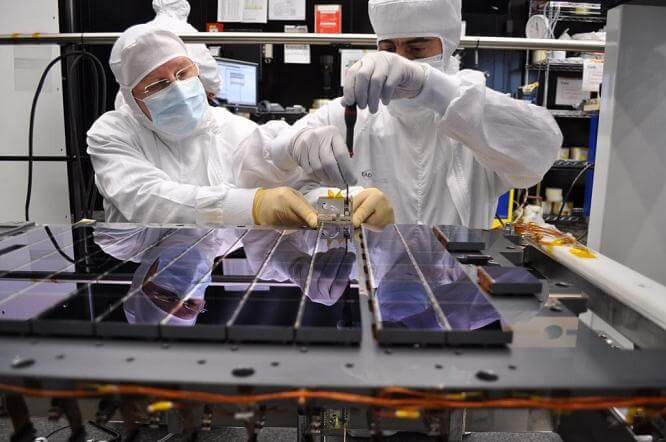On the European Space Agency's Gaia mission, 106 electron boards are carefully assembled together to create the largest digital camera in history. And the good part: the goal of the mission is a three-dimensional mapping of the Milky Way

Here on Earth we explore space using astronomical CCD cameras that reach a million pixels, a respectable number by all accounts. Can you describe what a billion pixel camera can do? This is the plan for the Gaia mission (GAIA Global Astrometric Interferometer for Astrophysics, or Global Astrometric Interferometer for astrophysics). In this European Space Agency mission, 106 electronic boards are assembled together with great care, to create the largest digital camera in history. And the good part: the goal of the mission is a three-dimensional mapping of the Milky Way.
In 2013, Gaia will begin its five-year mission. During the mission, Gaia will photograph about a billion stars and measure their brightness, their spectral characteristics, their self-motion in space and their position. The information will be collected by its massive array of digital photo panels. Each of the 106 panels in the spacecraft is smaller than a credit card and thinner than a human hair, and each panel has an array of light-receiving cells. To simplify the matter, each cell is its own "pixel". However, each such "pixel" can actually produce an image with hundreds and thousands of real pixels. When light hits the photovoltaic cells of the panel, electrons are generated during the entire exposure time (this is the photovoltaic effect). The electrons are "stored" in individual cells until a computer loads the entire array, counts the accumulated electrons and compiles the "big picture" (literally) from these values.
For a month, technicians worked on connecting all the photovoltaic panels to the installation on which they sit. The result is a flawless connection, with only a single mm separating the panels. "The installation of the panels and their exact location are key in the assembly of the optical plane of the spacecraft", said Philippa Gara, the payload manager of the Gaia mission. After the work is finished, there will be seven rows of CCD elements ready for work. 102 of all panels will be dedicated to star detection exclusively. The remaining four will repeatedly check the image quality from each of the two telescopes on the spacecraft. In addition, the panels will assist in monitoring the stability of the spacecraft, which has a field of view of 106.5 degrees (the human field of vision is about 120 degrees). As with any CCD, here too the temperature of the camera is important, which will be kept at a cold of -110 degrees Celsius.
Gaia's abilities when it comes to photography are quite respectable, but her weight is low. Most of the spacecraft, including the supporting frame, is made of composite materials. The spacecraft frame is resistant to deformations resulting from extreme temperatures, and weighs, with the CCD panels mounted on it, only 20 kg. It will be sent from Earth towards La Grange Point 2, 1.5 million km from Earth in the opposite direction from the Sun.
The Gaia mission is expected to measure one percent of the population of stars in the Milky Way. This may sound small, but even measurements of this small amount will produce for us a three-dimensional map of stars, which will be better than anything we have today.
Gaia is expected to launch into space in 2013.

2 תגובות
A little clarification is needed. According to the article, is the camera temperature kept at plus 110 degrees or minus 110 degrees (not clear from what is written)? And if the answer is minus 110 degrees, can someone explain how to do this in space at a distance of 1.5 million km from Mecca? Regarding plus 110 degrees, it seems simpler to me, but it is also interesting to know how to do it.
Stunning!